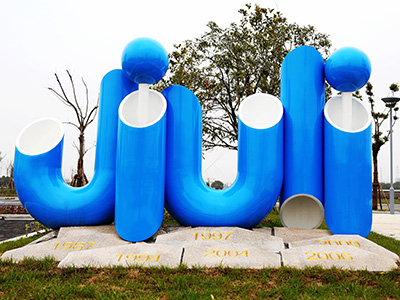The widespread and extensive application of nitrogen in stainless steel is the most significant progress in the field of stainless steel materials in the last decade. In addition to the ferritic stainless steel, nearly 10 years almost all types of stainless steel, especially the austenitic and duplex stainless steel are generally using nitrogen alloying, so that the austenitic and alpha + gamma entered the modern age of stainless steel, duplex stainless steel stainless steel is charged with nitrogen ([N] 0.10% or less, or [N] < 0.12%), medium nitrogen ([N] 0.40% or less, or [W] [N] > < 0.50%) and high nitrogen 0.4% or 0.50% or higher) [N] stainless steel, super austenitic stainless steel and super martensitic stainless steel with low nitrogen. Nitrogen in the duplex stainless steel can not prevent the precipitation of σ phase, but can inhibit the formation of σ phase. Duplex stainless steel has been in the formal due to join the nitrogen of second and third generation of duplex stainless steel (super duplex stainless steel and duplex stainless steel), duplex stainless steel has formed series, and became and martensite, ferritic, austenitic stainless steel, the three categories of steel class, because the nitrogen solubility in the ferritic stainless steel is extremely low, and high solubility in austenite, thus the beneficial role of nitrogen in the duplex stainless steel is mainly reflected in improving performance of austenitic organization.
Nitrogen in the duplex stainless steel can delay the high temperature fusion of austenitic phase (γ) and promote the precipitation of secondary austenite (γ2) in the heat-affected zone after welding, which is beneficial to the production, processing and welding of duplex stainless steel. Nitrogen is the only gaseous alloying element used in stainless steel. It is easy to take, unlimited in quantity, low in price, convenient to add in production, and has significant beneficial effects, but few side effects. It is an important alloying element for modern stainless steel clocks with a very promising future.
Nitrogen significantly increases the room temperature and high temperature strength of austenite and duplex stainless steel through solid solution strengthening (Fig. 1). The addition of 0.1%N to Cr-Ni austenitic stainless steel can increase the strength of the steel by 60-100MPa, but the plasticity and toughness of the steel are not significantly reduced when the amount of nitrogen is suitable. The high nitrogen austenitic stainless steel can obtain very high strength with the addition of large amount of nitrogen, but the fracture toughness does not decrease.

Figure 1. Effect of nitrogen on the strength of 00Cr17Ni14Mo2 stainless steel
Nitrogen not only significantly improves the overall corrosion resistance of the oxidizing acid and reducing acid media, but also improves the local corrosion resistance of the austenite and duplex stainless steel, such as intergranular corrosion, corrosion resistance point and crack resistance. Some experimental results are shown in Fig. 2~ 4. The results show that the ability of nitrogen in stainless steel to improve corrosion resistance and crevice corrosion resistance is 16-30 times that of chromium in stainless steel.

Fig. 2. Effect of nitrogen on corrosion properties of Cr-Ni-Mo austenitic stainless steels

Fig. 3. Effect of nitrogen on the pitting rate of 00CrNi6Mo3 steel

Fig. 4. Effect of nitrogen on crevice corrosion of 00Cr25Ni21~30Mo4 stainless steels
It is necessary to emphasize the beneficial effect of nitrogen on corrosion resistance in stainless steel, and it is necessary to contain enough chromium and molybdenum elements in steel. It is generally believed that nitrogen can promote the enrichment of chromium in the passivation film and improve the passivation ability of steel. Nitrogen can form NH3 and NH4+, which can increase the pH value of microsolution. The chromium-rich nitride forms at the interface between the metal and the passivation film, which further strengthens the stability of the passivation film. The study shows that nitrogen can also combine with molybdenum to form Ni2Mo2N in the dual-phase stainless steel, which makes the passivation film more stable and thus improves the corrosion resistance of the steel. Figure 5 shows the influence of nitrogen on the passivation film by improving the corrosion resistance of austenitic stainless steel.
Fig. 5. Schematic diagram of passivation film structure of austenitic stainless steels containing nitrogen
When the nitrogen content in steel over a certain amount will have some adverse impact on the performance of the stainless steel, such as for austenitic stainless steel, more than 0.12% ~ 0.15% nitrogen, cold steel, hot workability and cold forming performance drop soy sauce, the latter with nitrogen can reduce the layers of steel can be wrong, so as to improve the work hardening rate of austenitic stainless steel, make it related to the easy work hardening. When the nitrogen content is high, not only the thermoplasticity of steel is significantly reduced, which is unfavorable to hot working, but also the intergranular corrosion sensitivity of steel is increased due to the precipitation of Cr2N along grain boundaries. Nitrogen is a harmful element in ferritic stainless steels (more on this later). (From Introduction to Stainless Steel)


















